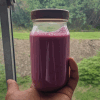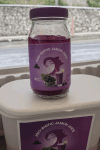Probiotic Enrichment of Jamun Juice With Streptococcus thermophilus: Effects on Antioxidant Activity and Quality
- PMID: 40761493
- PMCID: PMC12318823
- DOI: 10.1002/fsn3.70760
Probiotic Enrichment of Jamun Juice With Streptococcus thermophilus: Effects on Antioxidant Activity and Quality
Abstract
The increasing demand for functional beverages has driven interest in incorporating probiotics into fruit juices. This study investigates the functionalization of jamun juice with Streptococcus thermophilus (S. thermophilus), a thermophilic probiotic bacterium, to enhance its probiotic properties and assess storage stability under varying temperature conditions. S. thermophilus was isolated from commercial yogurt and identified through colony morphology, Gram staining, and catalase and oxidase tests. The probiotic culture was cultivated in nutrient broth and inoculated into 250 mL of pasteurized jamun juice using 1 mL of bacterial suspension at a concentration of 1.5 × 108 CFU/mL, resulting in a final concentration of 6.0 × 105 CFU/mL in the juice. The functionalized juice was stored at 37°C (incubation), 25°C (room temperature), and 4°C (refrigeration) for 28 days, during which microbial load, pH, sugar content, antioxidant activity, and sensory acceptability were monitored. Results showed a significant increase in microbial load at 37°C, peaking at 109 CFU/mL by Day 14. At room temperature and refrigeration, microbial growth remained minimal, with levels around 108 to 106 CFU/mL. The pH declined most rapidly at 37°C, and at the same temperature, sugar content decreased to 2.2 mg/mL by Day 21. Antioxidant activity, measured using the DPPH assay, was highest (82.35%) at 37°C, indicating enhanced probiotic metabolic activity. Sensory evaluations revealed improved acceptability with lower temperature storage, particularly at refrigeration temperatures, while higher temperatures led to a decrease in sensory quality. Functionalizing jamun juice with S. thermophilus improved its probiotic properties, with temperature playing a key role in maintaining these benefits. Refrigeration preserved both quality and probiotic stability, suggesting the potential of this probiotic jamun juice as a functional beverage. Future research could investigate its long-term stability, sensory characteristics, and nutritional profile, including the presence of bioactive compounds.
Keywords: Streptococcus thermophilus; antioxidant activity; functional beverage; jamun juice; probiotics.
© 2025 The Author(s). Food Science & Nutrition published by Wiley Periodicals LLC.
Conflict of interest statement
The authors declare no conflicts of interest.
Figures








References
-
- Amstrong, O. D. , Atamu D., Orhomedia E. H., and Destiny A.. 2016. “Effect of Different Storage Temperatures on the Viabilities Change of Probiotics in the Fish Feed.” International Journal of Biochemistry and Biotechnology 5, no. 4: 697–701.
-
- ASM . 2011. Catalase Test Protocol. American Society for Microbiology. https://asm.org/Protocols/Catalase‐Test‐Protocol.
-
- ASM . 2019. Oxidase Test Protocol. American Society for Microbiology. https://asm.org/Protocols/Oxidase‐Test‐Protocol.
LinkOut - more resources
Full Text Sources

